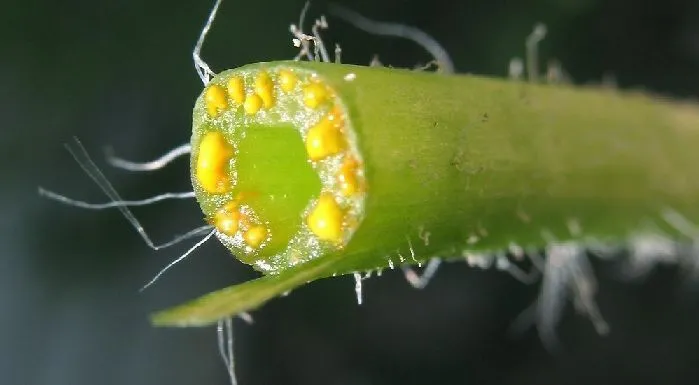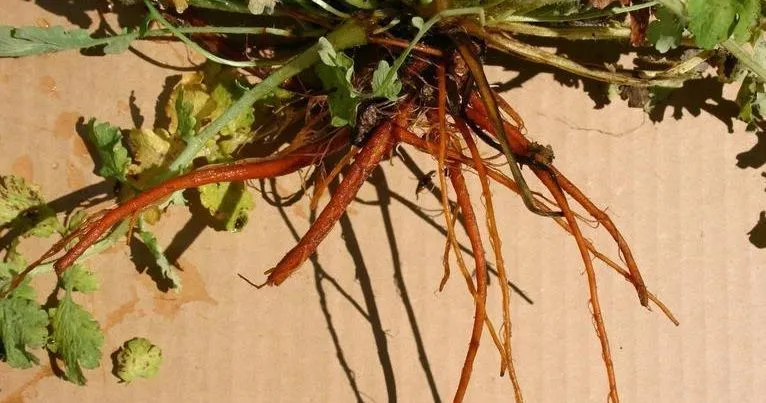We introduce a new medicinal plant commonly known as greater celandine (Chelidonium majus) and which has a great capacity for healing the list of problems that we will put below.
Best of all, they are supported by the scientific community through long-term trials with large sample sizes.
Table of Contents
Getting to know the Greater celandine plant (Chelidonium majus)
Some of the compounds that characterize the greater celandine are related to sedative, antiseptic, narcotic capacity, etc. And it is not for less since Chelidonium majus belongs to the family Papaveraceae.
This does not tell us anything but we open our eyes when we see that within this family also the poppy is found.
And of course, from the poppy (Papaver somniferum), widely cultivated in countries like Afghanistan, opium is extracted, a powerful drug from which we have morphine.
Greater celandine is a plant with elongated stems, growing above 50 cm in height. It has compound leaves, of a grayish green color, and flowers of 4 petals and yellow color quite showy.
It is characteristic of this plant, like others of the family Papaveraceae, produces an orange latex that has properties against the development of warts. Hence it’s the curious name of the wart plant.
It is distributed in different areas around the world, especially in occidental Asia, North America (introduced not long ago), and Europe.
To find celandine, we will have to walk through areas of thick grass, shaded that preserve moisture well, soils rich in organic matter (especially nitrogen), with good drainage and clay type.
As a curiosity to tell you that the name of the warty plant is given in 1600, by the European settlers who traveled to North America. We would be very interested to know at what point they discovered (always this kind of thing happens accidentally) that it had properties to cure warts.
Common names by which Chelidonium majus
- Greater celandine (the best-known name)
- Cirigueña (“cirigueña of all evils is owner”)
- Swallow
- Celandine
- Wart plant.
Medicinal properties of Greater celandine
To give more relevance to the medicinal properties of the Chelidonium majus, let’s put the chemical composition of its extracts.
Chemical composition
- Alpha and beta allocriptopina (also found in Glaucium arabicum)
- Berberine (quaternary ammonium salt with medicinal properties)
- Protoppina (inhibits histamine H1 receptor and platelet aggregation)
- Coptisina (for treatment of digestive disorders caused by bacterial infections)
- Chelidonenine (inhibitory activity of acetylcholinesterase and butyrylcholinesterase)
- Cheleritrin (potent inhibitor, selective, and cell-permeable protein kinase C)
- Sanguinarian (helps close wounds and against warts, corns, and tumors)
Chelidonium majus is credited with great antioxidant potential, derived from its flavonoids and alkaloids. These are found in greater quantity in the root, although they are present in the rest of the plant (source of information).
Although this plant belongs to traditional Chinese medicine, its potential as a medicinal plant, based on various healing remedies, is still being exploited.

1.- Improves liver development and protects the gallbladder
Chelidonium majus has purify medicinal properties, improving the liver system and eliminating toxins from the system. They protect the liver from cell damage and activate the liver function.
It has been used in traditional medicine for the treatment of liver diseases (related to inflammation of the liver). Therefore, the use of greater celandine is an effective treatment against jaundice or fibrosis.
As for the gall bladder, greater celandine is able to stimulate it and act protectively. stimulates the production and flow of pancreatic enzymes (including bile), preventing inflammation, infections, and diseases such as hepatitis.
This effect has also been seen and recognized in other medicinal plants, such as Agrimony (Eupatorium agrimony).
You may be interested in our article about the 10 Benefits of Purple Basil
2.- Chelidonium majus Stimulates and improves digestion
European health bodies have certified the use of greater celandine as the potential for the treatment of indigestion and gastric problems.
Chelidonium majus is especially useful when we suffer from digestive problems related to feelings of nausea, bloating, and heaviness, relieving indigestion.
Related to the above problem, it stimulates the production of gastric enzymes responsible for improving digestion and accelerating it, reducing the formation of stomach ulcers.
The possibilities of the cerigueña plant for the treatment of irritable bowel syndrome. Some sources suggest it but without medical evidence.
3.- Improves the skin and reduces eczema
The pure juice of Chelidonium majus has historically been used to treat a wide variety of skin problems, such as eczema. This scientific research also weighs its potential to treat atopic dermatitis.
Research carried out in 2010 and 2011 demonstrated the great potential of greater celandine for treating eczema in rats, with a significant healing effect. The symptoms of this condition were markedly reduced, including the itching and inflammation associated with this problem.
The next step is to demonstrate its potential to treat eczema and atopic dermatitis in humans.
4.- Sleep problems and anxiety
From the point of view of traditional use, it has historically been used to the wart plant as a painkiller, sedative, and in the face of anxiety. This is due to its narcotic properties (it comes from the family of poppies and opium).
However, its narcotic properties cannot be used in high doses as it is toxic.
In small doses, we can take advantage of its potential to reduce tension and anxiety (family, work, etc.), improve the ability to catch sleep, and have an analgesic effect if we suffer great pain.
5.- Chelidonium majus has an antimicrobial and disinfectant effect
Some of its chemical components allow acting as a disinfectant against the development of many potentially toxic microorganisms in the body.
In vitro studies demonstrated in several scientific investigations corroborate its potential as an antibacterial, including strains of Streptococcus mutants.
Let us remember that Streptococcus mutans is commonly find it in our mouths. It is the cause of tooth decay.
Although it may be related to this that we have discussed above, it has been used in a traditional way to reduce toothaches and gum pains.
This is more related to the analgesic effect it has. Chelidonium majus, although it also reduces the growth of potentially harmful bacteria when we suffer these pains, reduces oral infections.
According to medical research, this antibacterial effect of greater celandine comes from the chemical composition of Cheleritrin, present in the plant in moderate concentrations.
Used on the skin, it is also able to reduce conditions derived from warts, spots, and wounds, having the antiviral capacity (highlight possibilities against herpes) according to clinical experiments carried out in China and Russia.
You may be interested in our article about Bacopa monnieri: know its important benefits
6.- Cancer treatment
At the moment, research is continuing and the scientific community rejects some tests carried out previously because the minimum criteria applied are not met.
According to these trials, Chelidonium majus could be effective against the cell development of various tumors, improving the survival rate. Also, taken orally, it could have an effector antitumor in patients with stomach and esophageal cancer (source of information).
It is clear that scientific research on many medicines and medicinal plants is focused on finding elements that increase the survival rate against different types of cancer.
Hopefully, as for the plant Chelidonium majus, further research and favorable and accurate analytical results are obtained.
7.- Eye disorders
Chelidonium majus has been used frequently against eye disorders related to tired eyes, inflammation, and conjunctivitis. There are people who directly applied a crushed blade in a mortar on the ocular surface, with the eyelids closed.
- RELIABLE BRAND! 100% SATISFACTION: Heavenly Herbals, a brand of credibility and trust. Promoting your wellness is one of our primary goals when it comes to manufacturing natural herbals products and Homeopathic medicines.
- SATISFACTION GUARANTEED: We believe in the super quality of our products. If you are not completely satisfied with your purchase for any reason, we’ve got your back with a 30-day return policy, full money-back guarantee, excluding shipping. Do not hesitate to contact us for any information regarding your orders.
- SUGGESTED DOSAGE: Unless otherwise prescribed, mix 5-10 drops in half a cup of water, a smoothie, or a shake, 2-3 times a day.
How to apply Chelidonium majus

There are different applications of the greater celandine plant:
Fresh sap: in case of conjunctivitis, herpes, or warts, celandine diluted in boiling water is used, at a ratio of 1/20.
To treat a wart, apply the fresh sap, crush a leaf with a mortar, and extract the juice, 2 times a day for several consecutive days.
The whole plant can also be used in a poultice over a wound. In a mother tincture, take 5 drops, 3 times a day in water or apply directly on a wart or corn; for external use, diluted in 1 cup (250 ml) of boiling water to clean an open wound or in the case of infected mucous membranes.
A decoction made of the Chelidonium majus Fresh: 1 leaf for 1 cup (250 ml) of water – 3 times a day to cleanse the liver and gallbladder. Add chamomile, mint, or dandelion to improve the bitter and acidic taste of celandine.
Doing this type of healing for 3 weeks is an excellent way to treat eczema, psoriasis, and even arteriosclerosis (hardening of the arteries).
Cosmetic uses of Chelidonium majus: some leading companies in cosmetics use plant extract Chelidonium majus for anti-inflammatory and hypoallergenic purposes. It reduces skin irritations, has an antimicrobial effect, and has ascorbic acid and antioxidant potential.
In addition, it has an anti-inflammatory effect and reduces skin irritations.
Contraindications and precautions with Chelidonium majus
This plant should not be used for self-medication and is contraindicated during pregnancy.
Chelidonium majus can be toxic if concentrations are high, so you should consult with a medical specialist.
Due to its concentration in latex and is related to the same family of poppy (opium), it causes drowsiness, temporary paralysis of nerve endings, and a narcotic effect. High concentrations of coptisin from greater celandine cause cytotoxicity in high doses.
Of Chelidonium majus some cases of allergy and irritations have been diagnosed due to the presence of different alkaloids found in the sap of the plant.
Source of information
- Petruczynik A, Tuzimski T, Plech T, Misiurek J, Szalast K, Szymczak G. Comparison of Anticancer Activity and HPLC-DAD Determination of Selected Isoquinoline Alkaloids from Thalictrum foetidum, Berberis sp. and Chelidonium majus Extracts. Molecules. 2019 Sep 20;24(19):3417. doi: 10.3390/molecules24193417. PMID: 31547046; PMCID: PMC6803846.
- Gilca M, Gaman L, Panait E, Stoian I, Atanasiu V. Chelidonium majus–an integrative review: traditional knowledge versus modern findings. Forsch Komplementmed. 2010 Oct;17(5):241-8. doi: 10.1159/000321397. Epub 2010 Oct 8. PMID: 20980763.
- PRINCE, C. “Chelidonium majus” as a Cure for Cancer. Nature 55, 155 (1896).
- Warowicka, Alicja & Popenda, Lukasz & Bartkowiak, Grazyna & Musidlak, Oskar & Litowczenko, Jagoda & Kuzma, Dorota & Nawrot, Robert & Jurga, Stefan & Anna, gozdzicka-jozefiak. (2019). Protoberberine compounds extracted from Chelidonium majus L. as novel natural photosensitizers for cancer therapy. Phytomedicine. 64. 152919. 10.1016/j.phymed.2019.152919.

